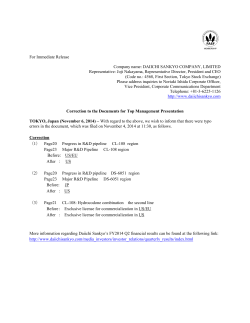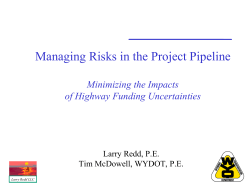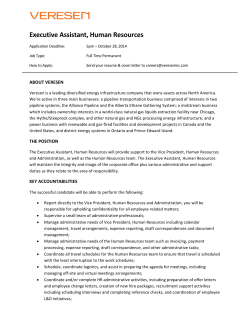
Document 416841
You are receiving this brochure because you live or work near production operations or a natural gas or petroleum pipeline or right-of-way. IMPORTANT SAFETY INFORMATION FOR YOU AND YOUR FAMILY ABOUT PIPELINES IN YOUR COMMUNITY. DEAR NEIGHBOR: You are receiving this brochure because you live or work near production operations or a natural gas or petroleum pipeline or right-of-way. This brochure contains information that will help you identify pipeline facilities, prevent damage to pipelines, and recognize and protect yourself and respond to a production or pipeline related emergency. Quicksilver Resources, Inc. and it subsidiaries are engaged in the development, production and transportation of natural gas, natural gas liquids, and oil throughout North America. Millions of miles of pipelines are used to move energy resources from areas of production to consumers. Pipelines are the most efficient, economical, and safest method of transporting our nation’s energy resources. As our neighbor, and a consumer of energy resources, we need your help to ensure the integrity and safety of pipeline operations. If you have any questions or concerns relating to the information found here, or you need to report an emergency, please contact us 24 hours a day at: 866-420-5396. Contact Quicksilver: Or visit: Other Resources: For General Questions ................................ (817) 665-5000 In an Emergency......................................... (866) 420-5396 www.qrinc.com/safety www.pipeline101.com www.pipelineawareness.org www.phmsa.dot.gov Barnett Shale Energy Education Council.............. www.bseec.org National Pipeline Mapping System ... www.npms.phmsa.dot.gov In an Emergency - 911 PRODUCTION SAFETY Quicksilver is engaged in activities related to the discovery, production, and gathering of natural gas. These activities include the extraction of natural gas from deep below the surface of the ground. Once produced, the gas is treated and processed to remove any impurities, and then transported to the marketplace for use in manufacturing or “Quicksilver consumption by end users. is dedicated The drilling process and equipment can be tempting to watch or climb on, but can be extremely hazardous to those who are not properly trained. Active production sites are secure areas and should never be approached or entered. to responsibly exploring and drilling for natural resources to ensure America’s future energy needs are met.” Quicksilver representatives visit active production facilities frequently to monitor operating wells and observe and maintain piping and equipment that help ensure the normal and safe operation of each facility. Production sites are outfitted with equipment, including relief devices, which will shut down the production facility if abnormal working conditions occur. Relief devices can release gas into the atmosphere to address a potential safety concern or operational issue. This can result in a noise similar to a whooshing sound and a controlled burning of gas. Quicksilver is dedicated to responsibly exploring and drilling for natural resources to ensure America’s future energy needs are met. If an emergency occurs at or near a production area, call 911. Do not enter the area or attempt to provide help. Our employees and local emergency responders are trained to safely respond in the event of an incident. CALL BEFORE YOU DIG! Even installing a mail box, privacy fence, flagpole or storage building could pose a hazard within the right-ofway. Before you dig, drill, blast or move any earth near a pipeline, contact your local one-call center by dialing 811. This call and service is provided at no charge to you and is required by law. 4 SIMPLE STEPS TO DIGGING SAFELY 1 Contact your state’s one-call center by dialing 811 at least 48 hours (not including weekends or holidays) before you want to dig. 2 Wait for facility owners to mark their underground facilities using paint, flags and/or stakes. 3 Confirm that all facilities have been marked. If you know or believe that facilities have not been properly marked, you must make another call to the one-call center before beginning any excavation work. 4 Use caution near underground facilities. Obey safe excavating practices and state laws. PIPELINE DAMAGE If you damage a pipeline while excavating, please notify Quicksilver personnel immediately at (866) 420-5396. While the damage could only appear minor, a gouge, scrape, dent or crease to the pipe or coating could harm the integrity of the pipeline and cause a future break or leak. In Texas, any person planning to excavate must follow requirements found in Chapter 18 of the Railroad Commission Rules. To learn what is required, visit: www.qrinc.com/safety/ TXdamageprevention. PIPELINE MARKERS Pipelines are buried in areas called rights-of-way. Pipeline markers are used to designate the general route of the pipeline. Markers can also be found where a pipeline crosses a street or railroad, emerges from the earth, or in waterways. Be aware: Pipeline markers will not designate the exact location, depth or number of pipelines in the area. MARKERS COME IN DIFFERENT SHAPES AND SIZES, BUT WILL ALWAYS: IDENTIFY MATERIAL BEING TRANSPORTED AND THE EXISTENCE OF THE RIGHT-OF-WAY HAVE THE WORD “WARNING,” “DANGER,” OR “CAUTION” IN HIGHLY VISIBLE, BRIGHT COLORS NATURAL GAS PIPELINE BEFORE DIGGING OR IN AN EMERGENCY CALL 866-420-5396 QUICKSILVER RESOURCES INC. PROVIDE A NUMBER TO REACH THE COMPANY IN THE EVENT OF AN EMERGENCY 24 HOURS A DAY, 7 DAYS A WEEK PROVIDE THE NAME OF THE PIPELINE COMPANY LEAK RECOGNITION AND RESPONSE Because of the extensive measures taken by Quicksilver and other pipeline companies to prevent pipeline leaks, accidents are rare. The most frequent causes of pipeline failures are third party excavation and corrosion. The consequences of a pipeline incident will vary depending on the product being transported, the amount of the product lost, and the area in which the accident occurs. As our neighbor, it is important for you to be able to recognize the signs of a potential pipeline incident and know how to respond. Use your senses to recognize a potential pipeline emergency: Do you SEE: Do you SMELL: • • • • • • Persistent bubbling in standing water Discolored vegetation A dense cloud or fog Slight mist of ice Unexplained frozen ground near a pipeline Fire or explosion • Strange or unusual odor similar to petrochemicals or rotten eggs Do you hear: • Unusual noises or a hissing or roaring sound Actions to take if you suspect a pipeline leak or rupture: Do the following: • Abandon any equipment in its current operational state • Leave the area on foot immediately • Move in an upwind/crosswind direction away from the incident • Once in a safe place, call 911 and the pipeline operator • Warn others to stay away • Create any sources of ignition, such as heat or sparks Do Not • Start a car, turn off any switches or light a cigarette • Attempt to turn any pipeline valves do any of • Use a phone or cell phone while near the suspected leak the following: • Walk or drive into or near a vapor cloud • Touch the escaping liquid or gas • Attempt to extinguish or control a fire
© Copyright 2025













